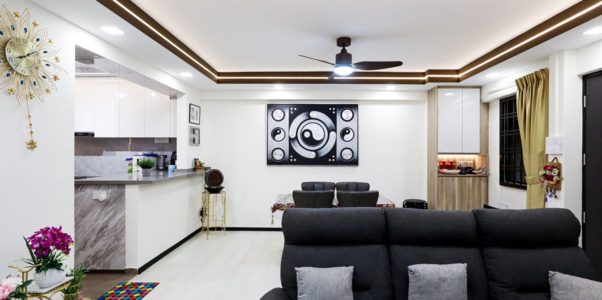What is the importance of good lighting in the home? There are many different types of lighting, each with its own purpose. Ambient lighting provides general illumination for a room, while task lighting is designed to provide focused light for specific tasks. Accent lighting is used to highlight specific objects or features in a room.

What Good lighting can?:
- Make your home safer by providing adequate light for walking, cooking, and other activities.
- Improve your mood and energy levels by providing natural light or by using light bulbs with a warm color temperature.
- Highlight the architectural features of your home.
- Create a more inviting and relaxing atmosphere.
What are the different types of lighting and how are they used? Lighting plays a crucial role in creating the right ambiance and functionality in a space. There are three primary types of lighting: ambient, task, and accent lighting.
Ambient lighting serves as the overall illumination for a room, providing a comfortable level of brightness. It is often used in combination with other lighting types to create a balanced and inviting atmosphere. For example, recessed lights or chandeliers can be used to achieve ambient lighting.
Task lighting is specifically designed to assist in performing focused activities. It is employed to illuminate particular areas where tasks like reading, cooking, or working at a desk take place. Table lamps, floor lamps, or desk lamps are common sources of task lighting, providing ample brightness and reducing eye strain.
Accent lighting is used to draw attention to specific objects or architectural features, adding visual interest and depth to a room. It helps create a focal point or highlight unique elements. Track lighting, wall sconces, or floor lamps can be utilized to achieve accent lighting, directing light to the desired area.
Now that we’ve covered the importance of good lighting in the home and the different types of lighting and their uses, let’s talk about how to choose the right lighting for each room.
How to choose the right lighting for each room?
The type of lighting you need will vary depending on the purpose of the room and the activities that take place there. For example, you’ll need different lighting for a bedroom than you would for a kitchen.
How can you select the ideal lighting for every room in your home? Determining the most suitable lighting for each room can significantly enhance its ambiance and functionality. By considering a few key factors such as the room’s purpose, size, natural light availability, and personal preferences, you can create a well-lit and inviting space that meets your specific needs. Whether you’re aiming for a cozy and relaxing atmosphere in your living room, a bright and focused environment in your study, or a soothing and calming vibe in your bedroom, understanding how to choose the right lighting is essential. Let’s delve into the process of selecting appropriate lighting fixtures, bulbs, and placement to bring out the best in each room.
Here are some of the things you’ll need to consider when choosing the right lighting for each room:
- The purpose of the room
- The activities that take place in the room
- The size of the room
- The style of the room
- Your budget

What should you consider regarding the style of your home?
The style of your home is the overall ambiance and aesthetics that define its look and feel. It is determined by the furniture, décor, and finishes, all of which contribute to the design and visual appeal of your space. The style of your home can range from traditional, modern, contemporary, to eclectic, each offering its own unique personality.
When selecting lighting options for your home, it is essential to consider the style and architecture of your space. This will help you choose lighting fixtures that harmonize with the overall ambiance and enhance the visual appeal.
For example, if you have a traditional-style home, you may want to opt for lighting fixtures that reflect the classic charm of the space. These fixtures are often made of wood, brass, or wrought iron, giving them a timeless look. Conversely, if you have a modern-style home, sleek and minimalist lighting fixtures made of metal or glass would be more suitable.
The style of your home is not only significant for its aesthetics but also for the way light is reflected within the rooms. If your home features dark furniture, selecting light-colored light bulbs can help brighten up the space, creating an open and airy atmosphere.
Ultimately, the goal of selecting lighting for your home is to create a space that is both functional and beautiful. By considering the style of your home
How do you budget for lighting?
When budgeting for lighting, you need to account for the expenses associated with purchasing lighting fixtures. Lighting fixtures include various types such as chandeliers, pendant lights, track lighting, wall sconces, and ceiling lights. The cost of lighting fixtures can vary significantly based on factors like the brand, design, materials used, and overall quality. Higher-end or designer lighting fixtures tend to be more expensive, while more affordable options are also available. It is essential to research and compare prices to find fixtures that fit within your budget without compromising on quality or style.
In addition to the cost of lighting fixtures, it’s important to consider the expenses related to light bulbs.
In addition to lighting fixtures, you must consider the cost of light bulbs when budgeting for lighting. Light bulbs come in different types, including incandescent, fluorescent, LED, and halogen. Each type has its own price range and energy efficiency. LED bulbs, for example, may have a higher upfront cost compared to incandescent bulbs, but they are known for their long lifespan and energy-saving benefits. When budgeting for light bulbs, you need to determine the quantity and type of bulbs required for each lighting fixture in your home. It’s advisable to consider the long-term cost-effectiveness and energy efficiency of the bulbs, as they can significantly impact your electricity bills over time.
By carefully considering the costs associated with both lighting fixtures and light bulbs, you can effectively budget for lighting and make informed decisions to ensure the desired illumination within your home while managing your expenses.



